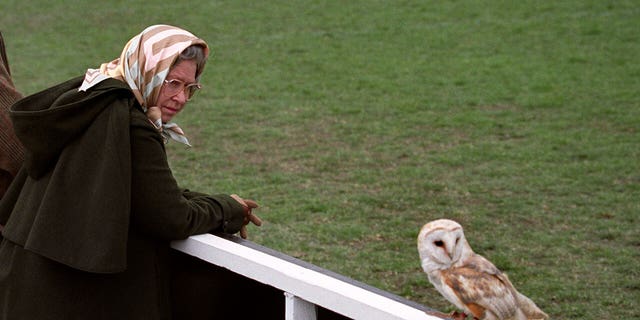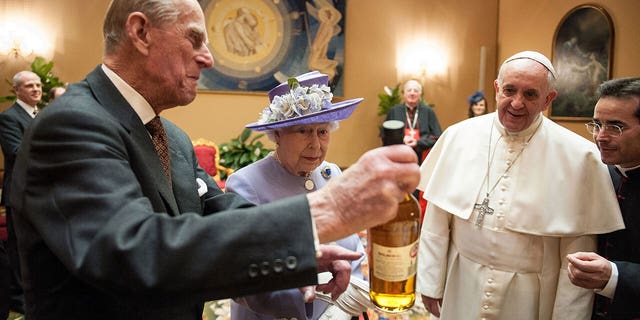From Queen Elizabeth II to King Charles III: A Changing of the Drams
You could call it the infamous grouse.
It plopped from the sky, striking the late Queen Elizabeth II on the shoulder.
The queen was out hiking the fields and hills near the River Dee close to Balmoral Castle in the Scottish Highlands in the early fall of 1995. What roiled Her Highness wasn’t a chunk of space debris or an engine bolt dislodged from an aircraft above.
It was a grouse. A dead one.
QUEEN ELIZABETH II’S PROCESSION AND THANKSGIVING SERVICE IN PICTURES
The fowl took flight. But then met its maker — and the queen — at practically the same moment, plunging from the air.
The queen was stunned and slightly bruised. But otherwise, uninjured. This is ironic because one of the queen’s favorite tipples was The Famous Grouse, a blended Scotch whisky produced at the distillery Glenturret in the southern Scottish Highlands.
It’s unclear if the bird that crashed into the queen was indeed THE famous grouse itself.
But the incident made that particular bird perhaps the most famous grouse in all of Scotland.
Outside of the whisky, of course.
QUEEN ELIZABETH II, BRITISH ROYAL FAMILY’S NET WORTH
The Famous Grouse was one of the queen’s treasured drams of whisky. Her late sister Princess Margaret enjoyed The Famous Grouse so much that a few bottles were often shipped ahead when she traveled. U.K. embassies around the world also knew to stock The Famous Grouse if Margaret was passing through.
Queen Elizabeth granted The Famous Grouse a “Royal Warrant” in the 1980s. That’s a special status the Crown rewards to certain businesses and firms to provide goods and services for the royals.

The British people appear to have taken a cue from the queen. The Famous Grouse is historically the best-selling Scotch in the United Kingdom.
The Famous Grouse was known just as “The Grouse” until the early 20th Century. Then the name was changed.
And “The Grouse” became famous.
Other malts that comprise The Famous Grouse come from Highland Park in the Orkney Islands to the north, Macallan in the Speyside region and the aforementioned Glenturret.
A LOOK BACK AT QUEEN ELIZABETH II’S CHILDREN: KING CHARLES III, PRINCESS ANNE, PRINCE ANDREW AND PRINCE EDWARD
While The Famous Grouse may represent one of the most-poured drams in the saloons of Balmoral, the queen and her predecessors also embraced a more “local” libation.
One mile to the southeast of Balmoral Castle sits the distillery Royal Lochnagar. “Royal” tells you all you need to know.
Prince Albert purchased the land around Balmoral in the mid-19th century for his wife, Queen Victoria. The dells and gulleys of the Scottish Highlands afforded royals an escape from the public view in London. It is said that Queen Victoria took a liking to expressions produced down the road from Balmoral at the new distillery.

Victoria granted Royal Lochnagar a Royal Warrant in 1848.
Royal Lochnagar, aged 12 years, is a creamy, custard-esque expression you’ll often find on American shelves.
The multinational firm Diageo owns Royal Lochnagar today. Diageo produces everything from Captain Morgan to Guinness to Pimm’s. It also boasts 28 distilleries in Scotland, each of which help make one of the best-known blended Scotches on the planet: Johnnie Walker.
You may find a few drops of whiskies made from Caol Ila, Talisker and Cardhu in Johnnie Walker. But you can bet there are also a few splashes of Royal Lochnagar in Johnnie Walker, too.
Diageo produced a special “Game of Thrones” set of whiskies from several of its Scottish distilleries. Among them was “the House of Baratheon,” a 12-year-old malt that pays homage to Stormlands on the east coast of Westeros from the series.
Queen Elizabeth adored the Scottish Highlands and the grounds around Balmoral. She and her family would retreat to Balmoral from July through October each year. A deft sportswoman, the late queen enjoyed riding horses in the Highlands. She relished fishing and even hunting deer.
But malts from the Scottish Highlands aren’t the only drams enjoyed by the royals.
Next, journey southwest to the Inner Hebrides islands. There, you’ll find Islay, which bills itself as “The Whisky Isle.”
When it comes to whisky, Scotland essentially has “two Napas.” Speyside is the larger region located in the north. And then there is Islay.
QUEEN ELIZABETH II REMEMBERED AS KING CHARLES III ASCENDS THE BRITISH THRONE
Bowmore (pronounced boh-MOHR, with an emphasis on the second syllable) is one of the oldest distilleries in Scotland. The government first licensed Bowmore in 1779 — although it’s believed Bowmore was distilling illicit whisky well before that.
Bowmore produced a special cask just for Queen Elizabeth in 1980. But it was never bottled until 2002. Known as the Queen’s Cask, the Crown would auction off a few bottles each year for charity.
The United Kingdom will undoubtedly witness a host of new customs and traditions under the reign of King Charles III.
That includes preferences in Scotch whisky.
Highland malts like Royal Lochnagar and The Famous Grouse are more floral and sweet. But expressions from Islay are invigorated with notes of peat, smoke, charcoal, rope and even nautical themes.
Laphroaig (pronounced luh-FROYG) is located on the southern tip of Islay. Laphroaig features one of the most distinct nose and palette presentations in the industry. There’s a bit of banana, clove and surprising sweetness in a nip of Laphroaig. But Laphroaig is a powerful malt. Laphroaig devotees sometimes compare its tastes to magic marker, bandages, iodine, beachside campfire and seaweed.
Yours truly has even characterized Laphroaig’s essences as “wet math homework ink from 1970s elementary school mimeograph machine.”
Laphroaig 10 is the standard release from this distillery and readily available in the United States.
KING CHARLES III ADDRESSED SCOTTISH PARLIAMENT FOR FIRST TIME FOLLOWING QUEEN ELIZABETH’S DEATH
King Charles — as Prince of Wales — granted Laphroaig a Royal Warrant in 1994. Charles has visited Islay and Laphroaig specifically on multiple occasions. And while in recent years Charles has done walkthroughs at Laphroaig’s rival on Islay, Ardbeg, Royal Lochnagar and the most northerly distillery on the mainland, Wolfburn, is said that Laphroaig is the sovereign’s favorite dram.
Specifically, Laphroaig 15 — if you can find it.
They may be royalty. But a visit from a member of the royal family to a distillery doesn’t always have a royal impact.

The queen opened the visitor’s center at the brand new Isle of Arran distillery in 1997. It was the first legal distillery to open on Arran in 160 years. Elizabeth sailed to Arran on the last voyage of the royal yacht Britannia, now dry-docked in Leith, Scotland.
The distillery displays a photograph of the Britannia steaming to the island through the Firth of Clyde en route to Arran.
But the queen’s visit may not have resonated.
During a visit to Arran in 2018, this reporter asked to see the location of the plaque noting the queen’s pilgrimage. Several distillery employees scurried around to see if they could locate the bronze panel, memorializing Elizabeth’s visit.
Alas, the embarrassed workers could not.
I can surmise only one thing:
Perhaps the plaque was taken out by an infamous grouse.
Read the full article Here


